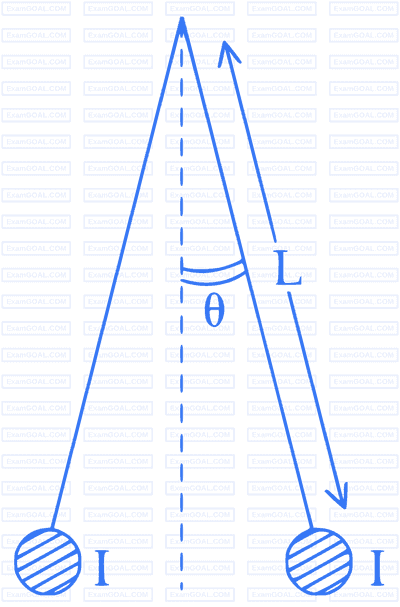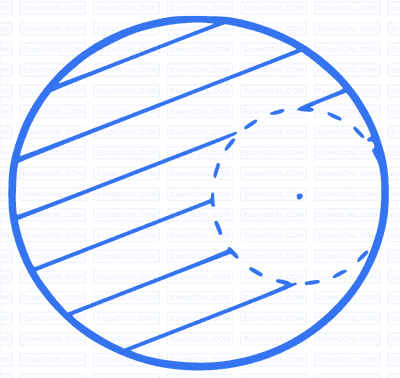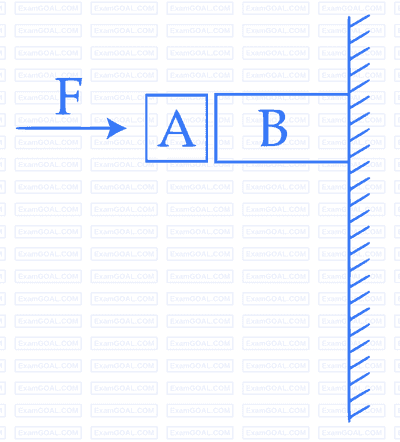1
As an electron makes a transition from an excited state to the ground state of a hydrogen - like atom/ion :
2
A red $$LED$$ emits light at $$0.1$$ watt uniformly around it. The amplitude of the electric field of the light at a distance of $$1$$ $$m$$ from the diode is :
3
Monochromatic light is incident on a glass prism of angle $$A$$. If the refractive index of the material of the prism is $$\mu $$, a ray, incident at an angle $$\theta $$. on the face $$AB$$ would get transmitted through the face $$AC$$ of the prism provided :

4
An inductor $$(L=0.03$$ $$H)$$ and a resistor $$\left( {R = 0.15\,k\Omega } \right)$$ are connected in series to a battery of $$15V$$ $$EMF$$ in a circuit shown below. The key $${K_1}$$ has been kept closed for a long time. Then at $$t=0$$, $${K_1}$$ is opened and key $${K_2}$$ is closed simultaneously. At $$t=1$$ $$ms,$$ the current in the circuit will be : $$\left( {{e^5} \cong 150} \right)$$

5
An $$LCR$$ circuit is equivalent to a damped pendulum. In an $$LCR$$ circuit the capacitor is charged to $${Q_0}$$ and then connected to the $$L$$ and $$R$$ as shown below :

If a student plots graphs of the square of maximum charge $$\left( {Q_{Max}^2} \right)$$ on the capacitor with time$$(t)$$ for two different values $${L_1}$$ and $${L_2}$$ $$\left( {{L_1} > {L_2}} \right)$$ of $$L$$ then which of the following represents this graph correctly ?
$$\left( {plots\,\,are\,\,schematic\,\,and\,\,niot\,\,drawn\,\,to\,\,scale} \right)$$
6
Assuming human pupil to have a radius of $$0.25$$ $$cm$$ and a comfortable viewing distance of $$25$$ $$cm$$, the minimum separation between two objects that human eye can resolve at $$500$$ $$nm$$ wavelength is :
7
On a hot summer night, the refractive index of air is smallest near the ground and increases with height from the ground. When a light beam is directed horizontally, the Huygens' principle leads us to conclude that as it travels, the light beam :
8
Two coaxial solenoids of different radius carry current $$I$$ in the same direction. $$\overrightarrow {{F_1}} $$ be the magnetic force on the inner solenoid due to the outer one and $$\overrightarrow {{F_2}} $$ be the magnetic force on the outer solenoid due to the inner one. Then :
9
A rectangular loop of sides $$10$$ $$cm$$ and $$5$$ $$cm$$ carrying a current $$1$$ of $$12A$$ is placed in different orientations as shown in the figures below :

If there is a uniform magnetic field of $$0.3$$ $$T$$ in the positive $$z$$ direction, in which orientations the loop would be in $$(i)$$ stable equilibrium and $$(ii)$$ unstable equilibrium ?
10
Two stones are thrown up simultaneously from the edge of a cliff $$240$$ $$m$$ high with initial speed of $$10$$ $$m/s$$ and $$40$$ $$m/s$$ respectively. Which of the following graph best represents the time variation of relative position of the second stone with respect to the first ?
(Assume stones do not rebound after hitting the ground and neglect air resistance, take $$g = 10m/{s^2}$$)
(The figures are schematic and not drawn to scale)
11

In the circuit shown, the current in the $$1\Omega $$ resistor is :
12
Two long current carrying thin wires, both with current $$I,$$ are held by insulating threads of length $$L$$ and are in equilibrium as shown in the figure, with threads making an angle $$'\theta '$$ with the vertical. If wires have mass $$\lambda $$ per unit-length then the value of $$I$$ is :
($$g=$$ $$gravitational$$ $$acceleration$$ )

13
When $$5V$$ potential difference is applied across a wire of length $$0.1$$ $$m,$$ the drift speed of electrons is $$2.5 \times {10^{ - 4}}\,\,m{s^{ - 1}}.$$ If the electron density in the wire is $$8 \times {10^{28}}\,\,{m^{ - 3}},$$ the resistivity of the material is close to :
14
A long cylindrical shell carries positives surfaces change $$\sigma $$ in the upper half and negative surface charge - $$\sigma $$ in the lower half. The electric field lines around the cylinder will look like figure given in :
(figures are schematic and not drawn to scale)
15
A uniformly charged solid sphere of radius $$R$$ has potential $${V_0}$$ (measured with respect to $$\infty $$) on its surface. For this sphere the equipotential surfaces with potentials $${{3{V_0}} \over 2},\,{{5{V_0}} \over 4},\,{{3{V_0}} \over 4}$$ and $${{{V_0}} \over 4}$$ have radius $${R_1},\,\,{R_2},\,\,{R_3}$$ and $${R_4}$$ respectively. Then
16
In the given circuit, charges $${Q_2}$$ on the $$2\mu F$$ capacitor changes as $$C$$ is varied from $$1\,\mu F$$ to $$3\mu F.$$ $${Q_2}$$ as a function of $$'C'$$ is given properly by:
$$\left( {figures\,\,are\,\,drawn\,\,schematically\,\,and\,\,are\,\,not\,\,to\,\,scale} \right)$$

17
For a simple pendulum, a graph is plotted between its kinetic energy $$(KE)$$ and potential energy $$(PE)$$ against its displacement $$d.$$ Which one of the following represents these correctly?
$$(graphs$$ $$are$$ $$schematic$$ $$and$$ $$not$$ $$drawn$$ $$to$$ $$scale)$$
18
A pendulum made of a uniform wire of cross sectional area $$A$$ has time period $$T.$$ When an additional mass $$M$$ is added to its bob, the time period changes to $${T_{M.}}$$ If the Young's modulus of the material of the wire is $$Y$$ then $${1 \over Y}$$ is equal to :
($$g=$$ $$gravitational$$ $$acceleration$$)
19
From a solid sphere of mass $$M$$ and radius $$R,$$ a spherical portion of radius $$R/2$$ is removed, as shown in the figure. Taking gravitational potential $$V=0$$ at $$r = \infty ,$$ the potential at the center of the cavity thus formed is:
($$G=gravitational $$ $$constant$$)

20
Consider a spherical shell of radius $$R$$ at temperature $$T$$. The black body radiation inside it can be considered as an ideal gas of photons with internal energy per unit volume $$u = {U \over V}\, \propto \,{T^4}$$ and pressure $$p = {1 \over 3}\left( {{U \over V}} \right)$$ . If the shell now undergoes an adiabatic expansion the relation between $$T$$ and $$R$$ is:
21
Consider an ideal gas confined in an isolated closed chamber. As the gas undergoes an adiabatic expansion, the average time of collision between molecules increases as $${V^q},$$ where $$V$$ is the volume of the gas. The value of $$q$$ is: $$\left( {\gamma = {{{C_p}} \over {{C_v}}}} \right)$$
22
A solid body of constant heat capacity $$1$$ $$J/{}^ \circ C$$ is being heated by keeping it in contact with reservoirs in two ways:
$$(i)$$ Sequentially keeping in contact with $$2$$ reservoirs such that each reservoir
$$\,\,\,\,\,\,\,\,$$supplies same amount of heat.
$$(ii)$$ Sequentially keeping in contact with $$8$$ reservoirs such that each reservoir
$$\,\,\,\,\,\,\,\,\,\,$$supplies same amount of heat.
In both the cases body is brought from initial temperature $${100^ \circ }C$$ to final temperature $${200^ \circ }C$$. Entropy change of the body in the two cases respectively is :
23

Given in the figure are two blocks $$A$$ and $$B$$ of weight 20 N and 100 N, respectively. These are being pressed against a wall by a force $$F$$ as shown. If the coefficient of friction between the blocks is 0.1 and between block $$B$$ and the wall is 0.15, the frictional force applied by the wall on block $$B$$ is :
24
From a solid sphere of mass $$M$$ and radius $$R$$ a cube of maximum possible volume is cut. Moment of inertia of cube about an axis passing through its center and perpendicular to one of its face is:
25
Distance of the center of mass of a solid uniform cone from its vertex is $$z{}_0$$. If the radius of its base is $$R$$ and its height is $$h$$ then $$z{}_0$$ is equal to :
26
A particle of mass $$m$$ moving in the $$x$$ direction with speed $$2v$$ is hit by another particle of mass $$2m$$ moving in the $$y$$ direction with speed $$v.$$ If the collision is perfectly inelastic, the percentage loss in the energy during the collision is close to:
27
The period of oscillation of a simple pendulum is $$T = 2\pi \sqrt {{L \over g}} $$. Measured value of L is 20.0 cm known to 1 mm accuracy and time for 100 oscillations of the pendulum is found to be 90 s using wrist watch of 1 s resolution. The accuracy in the determination of g is:










